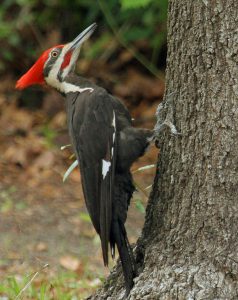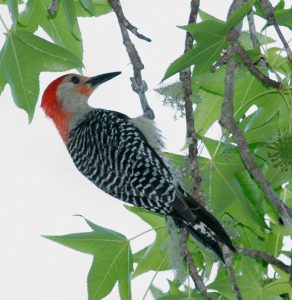While most of us can deduce that a woodpecker is in the area by the resonance of their drumming, we may not know which pal from the Picidae family has stopped by for a visit.
Unfortunately, woodpeckers of the Southeast are all black, white, and red so it can be challenging to keep them straight. That said, the three most common woodpeckers in our area – Pileated, Red-Bellied, and Downy – are distinct enough that with a little practice, you’ll be ID-ing your neighborhood excavators in no time.
Head over to YouTube for an in-depth look into woodpecker adaptations, identification, and conservation in our Wild Sarasota Webinar: Woodpeckers of Florida.
Pileated Woodpecker (Dyrocopus pileatus)

Height: 16-19 in
Primary Habitat: Deciduous or deciduous-coniferous woodlands
Coloring Keys
-
-
- Triangular red crest
- White stripes continuing across face and down neck
- White underwings visible during flight
- Males have a red moustache
-
Pileated woodpeckers are the largest woodpecker found in North America and have no extant (living) look-alike. So, if you’ve seen a tall woodpecker with the classic, Woody the Woodpecker red crest, it’s likely a Pileated.
Red-Bellied Woodpecker (Melanerpes carolinus)

Height: ~9in
Habitat: Forests, woodlands, wooded suburbs, and wetlands
Coloring keys:
- Black and white barred back
- Reddish-tan underbellies
- Red napes and males have a red crown
- White patches near wingtips during flight
Although their name is a bit misleading with a rarely visible underside, Red-bellied woodpeckers are the most frequently sighted woodpeckers in suburban areas like Sarasota. Their distinctive black and white barred back feathers and red napes are good signals. And, if you were to ever see one close up or flying overhead, you can just make out the reddish tint to their bellies that begets their name.
Downy Woodpecker (Dryobates pubescens)

Height: 6in
Habitat: Open woodlands and wooded suburbs
Coloring keys:
-
-
- Black and white back feathers with a white stripe
- Checkered black and white pattern on the wings
- Boldly striped black and white head
- Males have a small red patch on back of head
-
The most prevalent woodpecker in Florida, the Downy woodpecker is arguably the hardest of the group to identify. Much like the Red-bellied woodpecker, it has a black and white back and sometimes red plumage on its head, but the Downy has a solid white stripe down its back and distinctive black banding on its face.
The hardest differentiation to make, however, is between a Hairy and a Downy woodpecker because they share so many coloring similarities. The biggest clue is beak length. Downy beaks are smaller and only about a third the length of their head, while Hairy beaks are about as long as their head. The Downy is also the smallest woodpecker of eastern North America and the Hairy is about 50% taller than 6 inches of a Downy. If none of these hints are a giveaway, it’s a safe bet to call it a Downy as they are much more abundant than the Hairy especially in suburbia.
Woodpecker Calls
If you have a keen ear, there are ways to distinguish between species with their calls. Check out the links below to familiarize yourself with their distinctive vocalizations.
Pileated Woodpecker (clear piping or short wuk, wuk)
Red-Bellied Woodpecker (shrill, rolling kwirr or churr)
Downy Woodpecker (whinnying)
It’s also possible to determine the gender of woodpeckers by the amount of red they have, so pay attention to extra identification cues! As a general rule of thumb, male woodpeckers have more red than females.
With that, I send you off into the fields as infallible identifiers!
More Information
Interested in inviting more woodpeckers to your area? Here’s how to be a welcoming neighbor:
- Leave snags and old trees for perching, pecking, and cavity excavation
- Hang bird feeders
- Seeds
- Fruit (oranges)
- Mealworms
- Suet
And if you can’t stand the up to 12,000 pecks per day clattering on the siding of your house, here are some tips on maintenance.
- Cover siding with plastic
- Place netting or mesh three inches from surface
- Deter with noises and/or visuals like hawks and owls
Read more about helping cavity nesters here, or about deterring common wildlife here.
Read all our Wild Sarasota blogs HERE
Watch our Wild Sarasota Webinar: Woodpeckers of Florida.
 0
0
